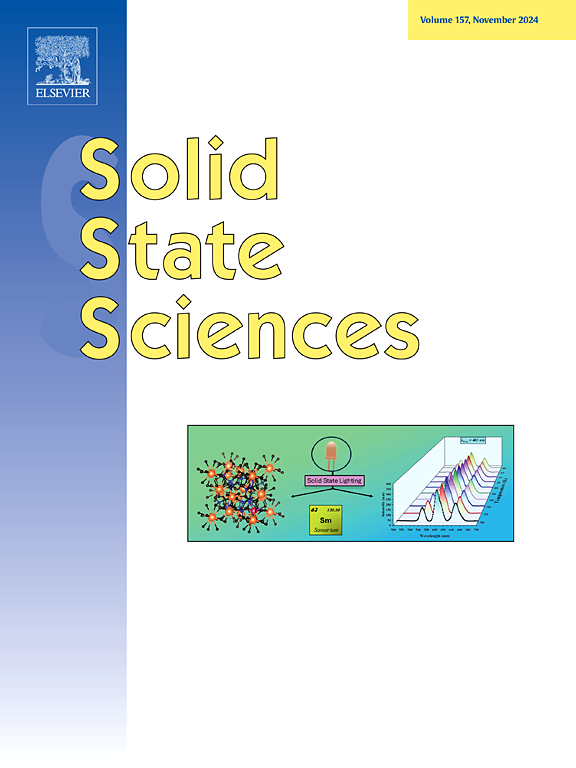Exploring Al- and Ga-based quaternary materials: Toward next-gen UV protection and solar efficiency
IF 3.3
3区 化学
Q2 CHEMISTRY, INORGANIC & NUCLEAR
引用次数: 0
Abstract
Coper-based quaternary chalcogenides have attained popularity due to their tunable structures, electronic, and optoelectronic properties, making these materials intriguing candidates for multifunctional applications. This study investigates the electronic, optoelectronic, elastic, and thermoelectric nature of MCuGeSe4 (M = Al, Ga) quaternary chalcogenide materials via density functional theory. The structural studies indicate that both of these compounds crystallize in the tetragonal I space group, with GaCuGeSe4 exhibiting better thermodynamic stability because of stronger atomic bonding. The electronic structure studies indicate that these materials possess a direct band gap in nature and have energy gap values of 1.28 eV for AlCuGeSe4 and 1.44 eV for GaCuGeSe4 using TB-mBJ. The density of states (DOS) investigation demonstrates significant hybridization, which correlates to charge transport and optical activity. The maximum absorption coefficients at 11.5 eV for AlCuGeSe4 and 10.5 eV for GaCuGeSe4, suggesting their potential for photovoltaic and optoelectronic applications. Thermoelectric studies suggest that the Seebeck coefficient improves with temperature, reaching 3.50 × 10−6 V/K in AlCuGeSe4 and 3.20 × 10−6 V/K in GaCuGeSe4 at 300 K. The figure of merit increases along the temperature, reaching to a value of about 0.45 for AlCuGeSe4 and 0.29 for GaCuGeSe4 at 650 K, implying the potential for thermoelectric applications. MCuGeSe4 chalcogenides provide excellent electrical, optical, and thermoelectric properties, which make them ideal for photovoltaic, optoelectronic, and energy-harvesting applications.

探索Al和ga基季系材料:迈向新一代紫外线防护和太阳能效率
铜基季硫族化合物由于其可调的结构、电子和光电子性质而受到欢迎,使这些材料成为多功能应用的有趣候选者。本研究通过密度泛函理论研究了MCuGeSe4 (M = Al, Ga)四元硫系材料的电子、光电、弹性和热电性质。结构研究表明,这两种化合物都在I - 4的四方空间基中结晶,其中GaCuGeSe4由于原子键更强,表现出更好的热力学稳定性。电子结构研究表明,这些材料在本质上具有直接带隙,使用TB-mBJ的AlCuGeSe4和GaCuGeSe4的能隙值分别为1.28 eV和1.44 eV。态密度(DOS)的研究表明了明显的杂化现象,这与电荷输运和光活性有关。AlCuGeSe4的最大吸收系数为11.5 eV, GaCuGeSe4的最大吸收系数为10.5 eV,表明其在光伏和光电子领域的应用潜力。热电研究表明,塞贝克系数随着温度的升高而提高,在300 K时,AlCuGeSe4的塞贝克系数达到3.50 × 10−6 V/K, GaCuGeSe4的塞贝克系数达到3.20 × 10−6 V/K。在650 K时,AlCuGeSe4和GaCuGeSe4的优点值分别达到约0.45和0.29,这意味着热电应用的潜力。mccugese4硫族化合物具有优异的电学、光学和热电性能,这使它们成为光伏、光电和能量收集应用的理想选择。
本文章由计算机程序翻译,如有差异,请以英文原文为准。
求助全文
约1分钟内获得全文
求助全文
来源期刊

Solid State Sciences
化学-无机化学与核化学
CiteScore
6.60
自引率
2.90%
发文量
214
审稿时长
27 days
期刊介绍:
Solid State Sciences is the journal for researchers from the broad solid state chemistry and physics community. It publishes key articles on all aspects of solid state synthesis, structure-property relationships, theory and functionalities, in relation with experiments.
Key topics for stand-alone papers and special issues:
-Novel ways of synthesis, inorganic functional materials, including porous and glassy materials, hybrid organic-inorganic compounds and nanomaterials
-Physical properties, emphasizing but not limited to the electrical, magnetical and optical features
-Materials related to information technology and energy and environmental sciences.
The journal publishes feature articles from experts in the field upon invitation.
Solid State Sciences - your gateway to energy-related materials.
 求助内容:
求助内容: 应助结果提醒方式:
应助结果提醒方式:


